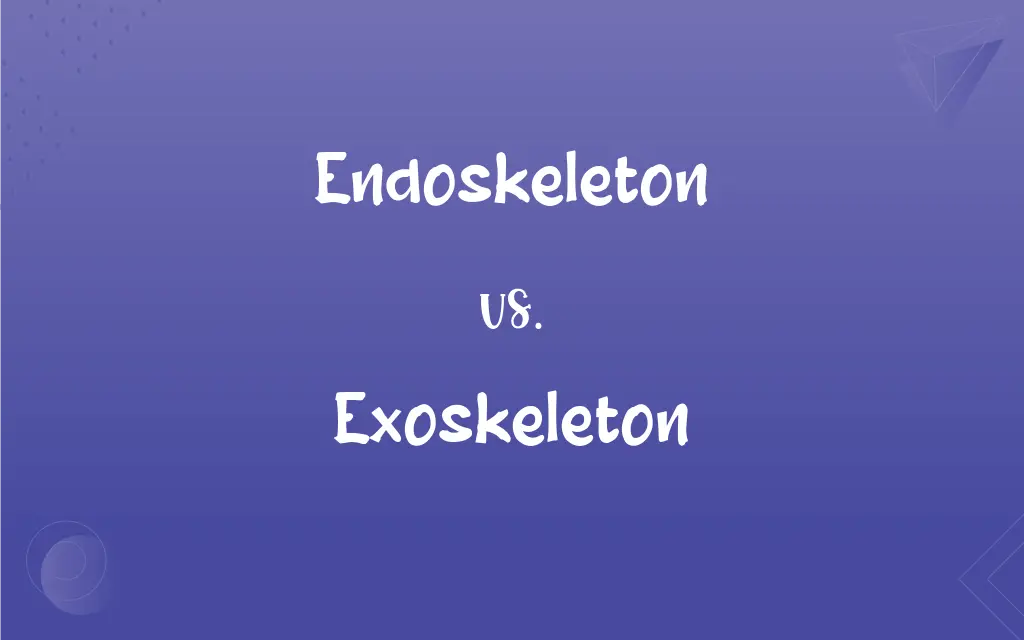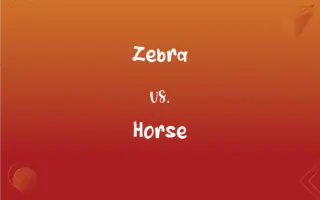Endoskeleton vs. Exoskeleton: What's the Difference?
Edited by Janet White || By Harlon Moss || Updated on October 28, 2023
Endoskeletons are internal support structures of bones and cartilage, while exoskeletons are external hard coverings or shells.

Key Differences
An endoskeleton is the internal framework made up of bone and cartilage that supports an organism's body from the inside. In contrast, an exoskeleton is an external, often rigid covering that provides both support and protection to certain animals, primarily invertebrates.
When considering growth, animals with an endoskeleton can grow continuously as the internal skeleton can expand in size. On the other hand, animals with an exoskeleton often need to molt or shed their external covering to grow, revealing a new, larger exoskeleton beneath.
Endoskeletons are commonly found in vertebrates, such as mammals, birds, reptiles, and fish. Exoskeletons, however, are primarily characteristic of arthropods like insects, spiders, and crustaceans.
In terms of material composition, the endoskeleton is usually made of bone and cartilage in vertebrates. Meanwhile, the exoskeleton of arthropods is typically composed of chitin, a hard and lightweight material.
Endoskeletons play a role in facilitating muscle attachment, allowing for a variety of movements and locomotion styles. Exoskeletons not only offer protection against predators and environmental factors but also offer a rigid structure against which muscles can work, enabling movement.
ADVERTISEMENT
Comparison Chart
Location
Internal
External
Growth
Can grow continuously
Requires molting for growth
Typical Organisms
Vertebrates (mammals, birds, fish)
Arthropods (insects, spiders, crustaceans)
Material Composition
Bone and cartilage
Chitin
Function
Supports body internally, facilitates muscle movement
Provides external support, protection, and movement
ADVERTISEMENT
Endoskeleton and Exoskeleton Definitions
Endoskeleton
The internal framework that provides support and shape.
The endoskeleton allows vertebrates to grow without shedding.
Exoskeleton
An external protective covering found in many invertebrates.
Crabs have a hard exoskeleton that offers protection.
Endoskeleton
An internal skeletal structure found in vertebrates.
Humans have an endoskeleton made up of bones.
Exoskeleton
Requires periodic molting to allow for growth.
Spiders shed their exoskeleton when they outgrow it.
Endoskeleton
Composed of bone and cartilage in most vertebrates.
The endoskeleton provides anchor points for muscles.
Exoskeleton
A rigid external covering for the body.
The exoskeleton of a beetle can be shiny and colorful.
Endoskeleton
A system of hard structures inside an organism.
Fish have an endoskeleton made primarily of bone.
Exoskeleton
Provides a structure against which muscles operate.
The rigid exoskeleton of arthropods aids in locomotion.
Endoskeleton
Facilitates complex movements due to muscle attachment.
Birds have a lightweight endoskeleton that aids in flight.
Exoskeleton
An outer shell or armor that supports and protects.
The exoskeleton of an insect is made of chitin.
Endoskeleton
An internal supporting skeleton, derived from the mesoderm, that is characteristic of vertebrates and certain invertebrates.
Exoskeleton
A hard outer structure, such as the shell of an insect or crustacean, that provides protection or support for an organism.
FAQs
What organisms typically have exoskeletons?
Arthropods, like insects, spiders, and crustaceans, have exoskeletons.
How do animals with an exoskeleton grow?
They molt or shed their exoskeleton and produce a new, larger one.
Are bones a part of the endoskeleton?
Yes, bones are a primary component of vertebrate endoskeletons.
What is an endoskeleton?
An endoskeleton is an internal skeletal structure found primarily in vertebrates.
Why do some animals have an exoskeleton instead of an endoskeleton?
Exoskeletons offer protection, a rigid structure for muscle movement, and can deter predators.
Are endoskeletons only made of bone?
No, they can be made of cartilage as well, especially in certain fish and young vertebrates.
What's the main function of an exoskeleton?
It provides protection, structural support, and aids in movement.
Do animals with endoskeletons molt?
No, animals with endoskeletons grow continuously and do not require molting.
How do endoskeletons develop?
Endoskeletons develop from the mesoderm during embryonic development.
Why do spiders occasionally leave behind a skin-like structure?
That's their old exoskeleton; spiders molt to grow.
What is the exoskeleton made of in insects?
The exoskeleton of insects is primarily made of chitin.
Do humans have an endoskeleton?
Yes, humans have an internal skeletal structure, which is an endoskeleton.
What material is the human endoskeleton made of?
The human endoskeleton is primarily made of bone and cartilage.
Can exoskeletons be soft?
Some exoskeletons can be relatively soft and flexible, especially before they harden or in specific organisms.
Do all arthropods have exoskeletons?
Yes, all arthropods possess an exoskeleton, though it may vary in composition and rigidity.
How does an endoskeleton support movement?
It provides anchor points for muscles, allowing for various movements and locomotion styles.
How do muscles connect to the exoskeleton?
Muscles attach to the inner surface of the exoskeleton.
Can an endoskeleton repair itself?
Yes, many organisms with endoskeletons can heal broken or damaged bones over time.
Is the exoskeleton a living tissue?
No, the exoskeleton is non-living material, though it is produced by living cells.
Can organisms have both an endo and exoskeleton?
While rare, some organisms like turtles have both an endoskeleton and a protective exoskeleton-like shell.
About Author
Written by
Harlon MossHarlon is a seasoned quality moderator and accomplished content writer for Difference Wiki. An alumnus of the prestigious University of California, he earned his degree in Computer Science. Leveraging his academic background, Harlon brings a meticulous and informed perspective to his work, ensuring content accuracy and excellence.
Edited by
Janet WhiteJanet White has been an esteemed writer and blogger for Difference Wiki. Holding a Master's degree in Science and Medical Journalism from the prestigious Boston University, she has consistently demonstrated her expertise and passion for her field. When she's not immersed in her work, Janet relishes her time exercising, delving into a good book, and cherishing moments with friends and family.































































